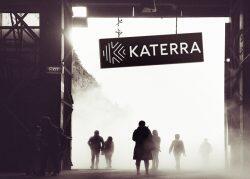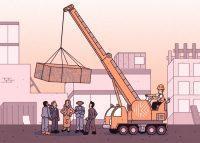Katerra’s cash position was “perilous.”
Its biggest backer, SoftBank, bailed out the construction startup with a $200 million investment in December. Three months later, Katerra’s primary lender, Greensill Capital, became insolvent, sending the startup’s clients scrambling to replace the general contractor on projects. Banks and insurance companies became increasingly squeamish about doing business with the firm, and a cash infusion from an expected deal with the sovereign wealth fund of Saudi Arabia never materialized.
By mid-May, Katerra desperately needed money.
It hired a restructuring consultant at investment bank Houlihan Lokey, which had helped save it from bankruptcy last year. Matthew Niemann, a managing director at the bank, went to Katerra’s founders — who had left the company — and to other stakeholders and third-party lenders to explore rescue options, but was turned down.
He came close to a deal with Kevin Genda’s Blue Torch Capital, but the firm, which buys debt from companies that are restructuring or in financial distress, ultimately decided against it.
SoftBank, which had poured more than $2 billion into the company since 2018, told Katerra that it “could not reasonably invest additional funds” into the company. It agreed, however, to provide $35 million to help it sell off its assets and wind down its U.S. operations. Katerra had requested $50 million.
“I analogize this to my 15-year-old daughter. [SoftBank] put us on a very strict program, what time we can get home at night, how far we can go on our bikes,” Niemann said during a virtual hearing this week in Texas bankruptcy court. “That said, it was the best we could do.”
Filings in Katerra’s bankruptcy provide new details on the months leading up to the firm’s demise. The company filed for Chapter 11 on Sunday and has already shut down 82 projects and laid off 730 of its 1,300 employees in the U.S. The company’s financial position is so dire that it asked the court to approve the immediate release of $15 million of the debtor-in-possession loan from SoftBank. Without it, Niemann said, Katerra would be “dead.”
Read more



Katerra burst onto the scene in 2015, growing rapidly by acquiring more than 20 businesses. It billed itself as a tech-first construction management firm that would streamline the building process by serving as the designer, construction manager and, in some cases, developer on projects. It opened its own factories to manufacture innovative building materials, such as cross-laminated timber and modular building components.
But its troubles were well-documented long before its rush for capital in May. The company had a spotty track record for delivering projects, laid off hundreds of employees, closed down factories and saw many leadership shake-ups. The company is also actively being investigated by the Securities and Exchange Commission, after it self-reported in August 2020 that employees of its renovations arm had inflated revenue and operating margin line items for 2018, 2019 and the first quarter of 2020, according to filings.
In a press release issued on Monday, Katerra blamed its collapse on the “unexpected insolvency” of a lender, though it does not name Greensill, and the pandemic.
In bankruptcy filings, however, Marc Liebman, Katerra’s recently appointed chief transformation officer, acknowledges that the company projects experienced “significant cost overruns, resulting in massive, ongoing losses.”
“Although Katerra won numerous projects, rapidly expanded its national footprint, and completed a series of successful capital raises, it was unable to generate a profit,” Liebman states in his declaration to the bankruptcy court.
He points to the company’s construction agreements, under which it guaranteed a maximum price its clients would need to pay, regardless of a project’s ultimate costs. Liebman also said Katerra provided discounts to “certain legacy customers.”
“In hindsight, those discounts were value-destructive,” he wrote.
Katerra hired Houlihan Lokey in September 2020 to explore “strategic alternatives,” according to Niemann. As part of that exploration, Niemann approached at least two of Katerra’s original founders, Jim Davidson and Fritz Wolff, and other potential investors. It is not clear if the third co-founder, Michael Marks, who was ousted as CEO last year, was part of that consortium.
rnrn“I analogize this to my 15-year-old daughter. [SoftBank] put us on a very strict program, what time we can get home at night, how far we can go on our bikes.”rnrn
The group of existing stakeholders, including SoftBank, and new investors came close to reaching a $380 million deal in exchange for a 90 percent ownership stake in Katerra, with the remaining 10 percent reserved for management. But negotiations broke down in November, according to filings.
Marks, along with Wolff and Davidson, could not be reached for comment.
Niemann said he had set out to find an option that did not involve hitting up SoftBank for additional capital. But the conglomerate turned out to be the only party willing to invest and agreed to provide the company with $200 million — $175 million in cash and the forgiveness of a $25 million loan. SoftBank also forgave a $440 million loan from SoftBank-backed financial-services firm Greensill. That aspect of the deal is now subject to a lawsuit brought by Credit Suisse, whose clients had bought that debt from Greensill.
According to the Wall Street Journal, SoftBank had provided that outstanding sum to Greensill expecting the money to go to Credit Suisse’s investors, but it did not.
Under the recapitalization, Katerra also reached an agreement with Fritz Wolff’s Wolff Companies, which had provided the startup with its only pipeline of projects in its initial years. Wolff Companies agreed to free Katerra from completion requirements on a number of active projects. In exchange, Wolff received a first lien security interest in Katerra’s cross-laminated timber factory in Spokane, Washington.
According to Niemann, Katerra offered its 20-plus subsidiaries an opportunity to buy back their businesses and release claims against the company. It is unclear how many of those deals were reached, though at least two subsidiaries, Michael Green Architecture and Equilibrium, have been transferring ownership back to the principals.
After this infusion of cash, however, Katerra’s problems snowballed. Greensill began insolvency proceedings in March. Katerra had expected to close in early 2021 on a deal in which the Public Investment Fund, Saudi Arabia’s sovereign wealth fund, would invest $147 million in Katerra Saudi Arabia in exchange for a 49 percent stake, according to filings. The company planned to use $23 million of that to meet obligations to a credit facility that was financing projects in the Middle East.
But that deal also fell apart, and the company had to use its own $23 million to meet those contract obligations. That led to issues with bonding projects and “massive liquidity constraints,” according to filings. Katerra recorded $2.78 billion in financial losses in 2018, 2019 and 2020.
SoftBank — which found itself in a similar situation with WeWork in 2019 — declined to provide any more financing to keep Katerra afloat. Instead, it agreed to provide a loan to unwind its U.S. operations and market its assets, which include operations in India and Saudi Arabia, where it was tapped to build 14,000 affordable housing units for the Saudi Arabia’s Housing Authority. It is also looking to sell equipment from its factory in Tracy, California.
The president of Katerra India said its operations were “business as usual.” The status of the housing development in Saudi Arabia was not immediately clear.
During this week’s hearing, Judge David Jones approved the requested release of $15 million of SoftBank’s debtor-in-possession loan, a type of financing that allows bankrupt companies to keep operating and gives the DIP lender a senior position on the company’s assets.
“We are very much a reluctant DIP lender here,” said Alfredo Perez of Weil Gotshal & Manges, who represented SoftBank at the hearing. “It’s not the position that we wanted to find ourselves in.”
